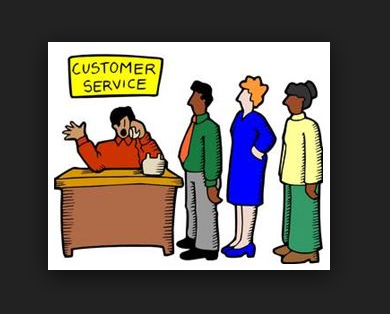Given the wealth of information available online, the need to learn to build relationships for business is becoming ever more important. One area to spend time and energy on is complaint handling.

Why? Because today’s consumers are more informed than you can imagine. This has resulted in a drastic shift in consumer power and has altered the selling process by placing a greater emphasis on both customer relationships and customer experience. Complaint handling plays a big part in these areas.
Most businesses do not have a clear understanding of what relationship building is and how to successfully put it into practice. Let’s debunk one misconception right from the start: Relationship building isn’t the opposite of traditional marketing, and it doesn’t exclude older channels (like email marketing and content marketing) in favor of solely using social media.
To clarify this important practice, today we’ll look at the most important recommendations in relationship-building campaigns. We’ll even give you the inside scoop from notable entrepreneurs on how relationships helped build the audiences that built their businesses.
Let’s get started.
What is Business Relationship Building?
With a focus on loyalty, retention, and long-term relationships, the aptly named practice of “relationship marketing” is designed around developing strong connections with customers by directly providing them with information that is tailored to their needs, wants, and interests.
As opposed to transactional marketing’s focus on direct sales, relationship marketing emphasizes increased word-of-mouth activity, repeat business, and a willingness on the customer’s part to provide information to the organization. And unlike “interruption” marketing, this process is started willingly via an opt-in by the customer.
Complaint handling … the value add
But is this focus on creating a relationship with customers worthwhile? As we previously discussed, the shocking truth of brand loyalty is that most customers do not want to be engaged with a business or brand; their priority is shared values.
The secret here is that the relationship marketing process has nothing to do with engagement and everything to do with being practically useful for both your business and customers.
According to a management study by Robin Buchanan and Crawford Gillies, the increased profitability associated with relationship building is the result of several factors:
Less “dating around.”
Satisfied, long-term customers in your marketing funnel are statistically less likely to switch. As a bonus, they tend to be less price-sensitive; experts say that customers who feel taken care of are less concerned about what they are paying.

Avoid the cost of acquisition
The famous Bain & Company analysis that it is 6 to 7 times more expensive to acquire a new customer than to keep a current one is something that keeps marketers up at night, but businesses with high rates of customer satisfaction needn’t worry about high churn rates.
It’s the foundation of the word-of-mouth
Strong relationships are essential to a high net promoter score, or, in other words, the chance that a customer will happily refer your business to a friend.
Your advocates are your rock
Regular customers tend to buy more often, and they are less expensive to maintain because of their familiarity with your business and the processes behind it.
Expansion becomes easier
Longstanding customers are much more likely to purchase your ancillary products and embrace your new ventures (think of those folks you know who buy each new Apple gadget).
Importance of business relationships … build customer trust
Most businesses today consider themselves to be trustworthy, and by yesterday’s standards, they are. They post their prices and rates honestly, they try their best to maintain the quality and reliability of their service, they protect the security of their customer’s funds, and they do what they promise.
But even though they don’t lie or steal, the fact is that the vast majority of financial services companies still generate substantial profits by fooling customers or capitalizing on their mistakes, or by taking advantage of them when they simply aren’t paying attention.
That approach in today’s environment is a direct route to customer attrition. Retention and growth now entail acting in customers’ best interest.
Acting in the customer’s interest requires companies to balance the benefit of an immediate profit against the cost of earning the respect and confidence of a customer—an asset that is, in the long term, far more valuable. Financial services companies must become more trustable because as the rising power of customers exposes untrustable behavior the question of a company’s trustability will go to the heart of its value proposition.
Trustability will become an essential element of any bank’s customer service in the future in much the same way that having a website has become an essential element of customer service today.
Complaint handling examples … for survival
To survive in this new, hyper-transparent world in which extreme trust is a prerequisite for business success, a firm must pursue these basic courses of action:
Building effective business relationships … good intentions
Having empathy for customers, and treating each one the way you would want to be treated if you were that customer, is the single most important element of trustability. To be trustable, you have to adopt a customer-centric philosophy, and then re-engineer your value proposition and customer experience from the standpoint of the customer. This will have consequences for your operating policies, of course, but the eventual implications for your firm’s culture will be even more profound. If your call center reps, tellers, and loan officers don’t believe you are a trustable company, then your customers won’t either.
Rethinking control
In the transparent future, you won’t be able to retain control over communications about your brand. The only thing you will control is how well your business processes protect your customers’ interests. To make your command-and-control, hierarchical firm more trustable, you will have to give more authority to individual employees, empowering them to “sense and respond” in real-time to customer issues. And don’t be too afraid to allow your workers to show your company’s human side, including its vulnerability. A little vulnerability will encourage customers to be empathetic to you, and empathy generates trust.
Ask good questions
Many people think good listening means always letting someone finish every thought and nodding along. Instead, active listening requires that you ask questions WHILE you are listening. Sometimes this means interrupting – but this isn’t something to be afraid of. Often the interruptions will lead to tangents that create more intersections for both of the people in a conversation.
Build community

One of the secrets behind the e-social revolution is that people have an irresistible urge to share with others. They make their opinions known, they contribute ideas, they collaborate on things such as Wikipedia and open-source software, and many companies even find that customers provide the best kind of customer service for other customers. If you want to become more trustable, you have to tap this sharing instinct, first by sharing your honest counsel with customers.
Talk to them not just regarding how they can get more value from their financial products, but how they can better manage their resources, and how they can save and spend responsibly. Facilitate customers collaborating with other customers, through online community platforms, social sharing sites, product reviews, and problem-solving customer forums.
Show competence
To be trustable not only must your intention be to act in the customer’s best interest, but you also have to have the competence to act on that intention. On a basic level, this means paying close attention to the quality of your product and service. But just as important, you should upgrade your data, analytics, and systems. Quantifying the financial benefits of long-term customer trust and confidence requires good analytics.
Customer lifetime values are not easy to compute, but in the financial services industry, more than in most other categories, statistical data is available, and there is no shortage of analytical tools to make these calculations. If you want your company to become more trustable, you’ll have to begin paying attention to the data and pushing the envelope on analysis.
Stimulate stories
There are questions that lead to answers, and then there are questions that lead to stories. Here’s one way you might start a story-seeking question, “What inspired you to …” When people share stories, they go beyond feeling like they are being interrogated. They open up, and they connect. The more stories you can hear, the more connection you’ll feel with everyone you speak to.
Make observations and draw assumptions
Consider starting questions with this phrase: “I noticed that you …” What happens when you are forced to think about this is that you start to consider what you know about someone before you meet them based on where you are, what they look like or what you know about them already.
One of the best conversations I had at an event recently was because I noticed that someone was using two different phones at the same time. Asking why led to an amazing conversation about time optimization and technology.
The bottom line
For customers who do want a relationship with your brand, their concerns are primarily about how useful you prove yourself to be (outside of your product).
In a world of extreme trust, you always have to take a step back from whatever business policy you’re considering, whatever new idea you’re thinking about, and ask yourself: “If this became public, would it be an embarrassment to us? Would we be proud of it? Would any of our customers hold it against us?”
Because in the highly interactive, extremely transparent future everything you do, every policy you have, will become public. Hidden fees won’t remain hidden, and bad intentions will be quickly exposed. If you want your financial services company to be genuinely trustable, then you have to have clean hands, not just a good alibi.

Need some help in building better customer trust from your customer engagement? Creative ideas to help grow your customer relationships?
All you get is what you bring to the fight. And that fight gets better every day you learn and apply new ideas.
When things are not what you want them to be, what’s most important is your next step. Call today.
Test. Learn. Improve. Repeat.
Are you devoting enough energy to improving your continuous learning for yourself and your team?
Mike Schoultz is the founder of Digital Spark Marketing, a digital marketing, and customer service agent. With 40 years of business experience, he blogs on topics that relate to improving the performance of your business. Find them on G+, Twitter, and LinkedIn.
Digital Spark Marketing will stretch your thinking and your ability to adapt to change. We also provide some fun and inspiration along the way.
More reading on customer engagement from our library:
Whole Foods Customer Engagement Using Social Media
Is Employee Engagement the Backbone of the Publix Culture?
13 Employee Engagement Lessons From Best Employee Brands
A positive Attitude Is Everything for Customer Engagement










